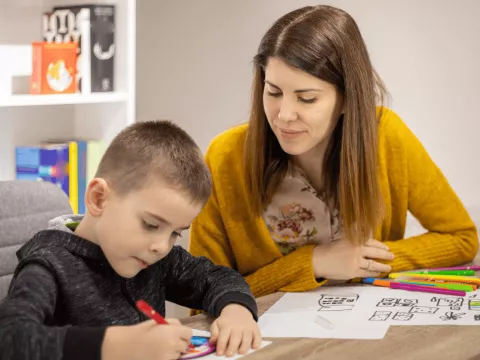- AdventHealth

Choose the health content that’s right for you, and get it delivered right in your inbox.
Like many bacteria and viruses, pink eye is common in children. However, though common, pediatric conjunctivitis requires special attention, as it can cause discomfort and potentially impact a child's daily activities. Understanding the symptoms, causes and appropriate care for pink eye in children is essential for maintaining their eye health and well-being.
Symptoms of Pink Eye in Children
Identifying the symptoms of pink eye in children is crucial for prompt diagnosis and appropriate care. If your child has pink eye, the first tell-tale sign is that their eyes will likely appear pink or red, and they may feel an itchy, burning or gritty feeling. Excessive tearing or discharge may also occur, typically leading to a crusty or sticky feeling around the eyes, particularly first thing in the morning or after a nap.
In addition, your child’s eyelids may become swollen and sensitive to light. Though they’ll likely feel irritated, your child must avoid rubbing or touching their eyes, as the irritation may worsen.
Causes and Prevention
Just like for adults, pink eye in children can have various causes. Understanding these causes and adopting preventive measures can help safeguard your child's eye health.
Viruses or bacteria often cause pink eye in children. Viral and bacterial conjunctivitis are both highly contagious forms of pink eye and are commonly associated with respiratory or bacterial infections. Encourage your children to wash their hands frequently, especially after playing outside or with friends. It’s also important for children to avoid touching their eyes to reduce the risk of infection.
Pink eye can also result from allergies. Common allergens for children include pollen, dust mites and pet dander. If you think your child’s pink eye might be due to an underlying allergen, the first step is to identify potential allergens and minimize your child’s exposure to them. A clean living space and an air purifier may also help prevent infection. Consult with a pediatric allergist for guidance on appropriately managing your child’s allergies.
Caring for a Child with Pink Eye
When your child has pink eye, providing proper care and comfort is essential. You can soothe your child’s conjunctivitis in several ways.
First, hand-washing when sick is just as important, if not more, than when healthy. Teach your child to wash their hands frequently, especially before and after touching their eyes or face. To prevent spreading the infection, provide your child with clean tissues or disposable wipes instead of sharing hand towels.
You can also apply a clean, warm compress to your child's eyes to alleviate discomfort and reduce swelling. Use a separate compress for each eye and gently press it against the affected eye for a few minutes. Repeat often, using a fresh compress each time.
Pink eye will normally clear up within 7-14 days without any medical treatment, but if symptoms persist, your child’s health care provider may prescribe eye drops or ointments to aid the healing process. Administer the medications as instructed, following proper dosage and hygiene notes.
Care and Support You Can Count On
If your child's symptoms worsen or persist or you have concerns about their eye health, seeking professional care is essential. AdventHealth offers expert pediatric eye care services to ensure the well-being of your child's eyes. Our compassionate team of emergency and urgent care specialists are available to provide your family with convenient, on-demand care.


